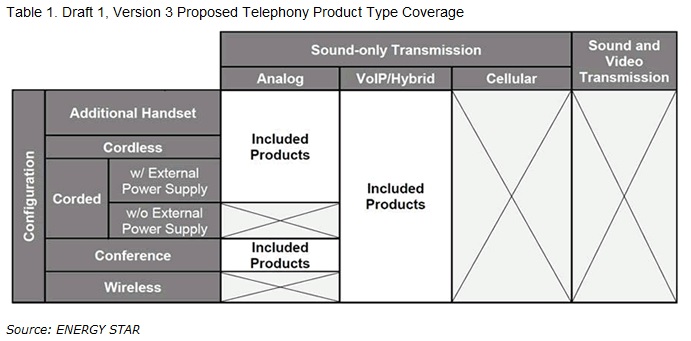A few weeks ago, the U.S. Environmental Protection Agency (EPA) published a new ENERGY STAR® draft specification (Draft 1, Version 3) aimed at improving the efficiency of end-user telephony equipment.
A lot has happened in this market since the current spec became effective in 2008. This proposed spec attempts to cover the product’s evolution since that time.
Program changes include:
- Product scope expansion to include Voice over IP (VoIP) and hybrid telephones, including conference phones
- Tightening of efficiency requirements of traditional products
- Incentives for products that incorporate off-mode, proxying, and the Energy Efficient Ethernet (IEEE 802.3az)
The products covered and excluded in the draft are shown in Table 1 below.

While the current program spec only requires products to comply with standby power levels and external power supply (EPS) level V performance*, the new draft proposes a more comprehensive approach, regulating power consumption based product type, capability, added functionality, and power management incentives. Besides meeting the current EPS efficiency levels, a product’s power consumption must be equal to or less than a “Maximum Average Power” level, determined by the equations below:
Equation 1: Power Requirement

Equation 2: Maximum Average Power
Equation 3: Off Mode Incentive
Where:
PP_ON is the power consumed when the product is 1)connected to power and a telephone line (or other physical or wireless network connection), 2) capable of receiving a call, 3) not receiving or transmitting sound, and 4) “hung-up” and the speakerphone is not engaged; POFF_INCENTIVE is calculated for VoIP and hybrid telephones that ship with an Off Mode, using Equation 3; PBASE is the base power allowance (W) found in Table 2; PADD is the power allowance (W) found in Table 3 for a total of n such allowances; PPROXY is an additional proxy incentive (W) found in Table 4; POFF is the power consumed when the product is connected to power and a telephone line (or other physical or wireless network connection) but is not capable of receiving a call without external stimulus.
Table 2. PBASE Allowances
|
Product Type |
PBASE (watts) |
|
Tested VoIP and Hybrid Cordless, Wireless, and Corded Telephones |
2.0 |
|
Tested VoIP and Hybrid Conference Telephones |
2.5 |
|
Analog Cordless, Corded, and Conference Telephones |
0.9 |
|
Additional Handsets Analog and VoIP |
0.3 |
Table 3. Additional Functional Adders
|
Feature |
Power AllowancePADD (watts) |
Notes |
|
Gigabit Ethernet (1000Base-T) |
1.0 |
Applies if the telephone has one or more Gigabit Ethernet Ports |
|
IEEE 802.3az compliant Gigabit Ethernet |
0.2 |
Telephony products that ship with IEEE 802.3az compliant Gigabit Ethernet ports may claim a 0.2 watt additional incentive |
Table 4. Additional Functional Adders
|
Capability |
PPROXY (watts) |
|
Base Capability |
0.3 |
|
Remote Wake |
0.5 |
The EPA plans to publish the final specification and test methods drafts by the end of this summer, allowing a program effective date by mid-2014.
A stakeholder webinar to discuss the proposed draft will be held on Tuesday, July 9th. To register, send an email request to by Wednesday, July 3rd. Stakeholder comments must be submitted by Friday, July 19th. All materials related to the test method and specification development can be downloaded by .
Per ENERGY STAR EPS Version 2 (for more information, click here).
Advertisement
Learn more about Electronic Products Magazine







